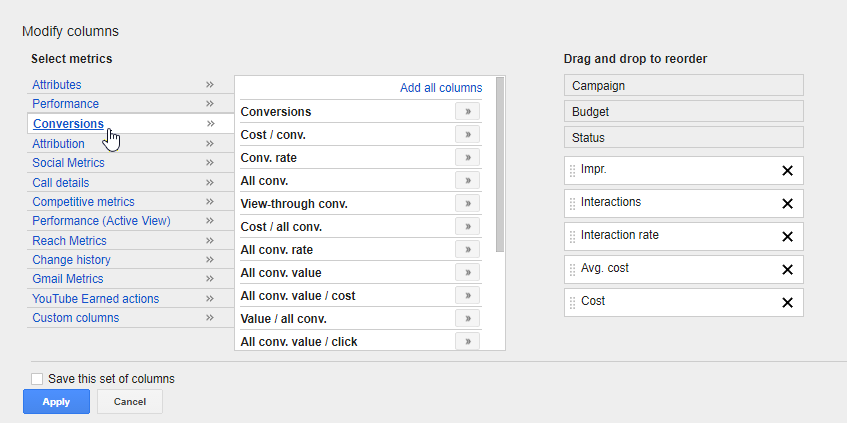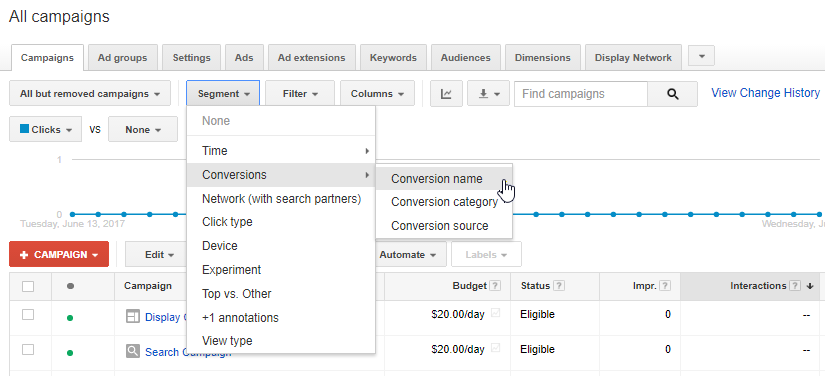Imagine driving down a winding road with no headlights. It’s unpredictable, unreliable, and downright terrifying! This scene paints a picture of what it’s like to run an AdWords account without tracking conversions. Without proof of measurable data, there is no way to accurately gauge campaign performance. If you say no to conversion tracking, you may as well kiss your wallet goodbye.
Sure, your ad can receive a great deal of clicks, but what happens when you’re draining your budget on those clicks and still not seeing a return on your investment? The real trick to making AdWords work for you is to track, analyze, and manage performance through conversion data.
The following steps to tracking conversions are going to equip you with the insight needed to turn your campaigns into a trusted asset.
1. Know Your Goals & Choose Your Conversion Type
Conversions show you the full story, from the first click to the final goal. They expose the truth of how your audience interacts with your ads and they paint a clear picture of what you need to do as an advertiser to reach your audience more effectively. The first step to tracking conversions is to establish the goal you wish to achieve with your AdWords campaign.
Let’s take a look at the various types of conversions you can use to meet your goal(s):

- Website
- Use this conversion type to track a wide variety of actions like purchases, form submissions, and pdf downloads.
- Phone calls
- Use this conversion type to track phone calls to your business.
- Apps
- Use this conversion type to track app downloads as well as in-app actions.
Think about what you need to accomplish using AdWords and think about how each one of these conversion types can play a part in getting you there.
For example, the owner of a national solar power installation company is using AdWords to generate more quality leads that he can turn into business. He wants to keep tabs on how potential customers are interacting with his ads and website so he implements a couple AdWords conversion tracking codes to see how well his ads meet the needs of his audience.
He sets up tracking for three types of conversions that highlight a full spectrum of data across various stages of the buyer’s journey. To capture interactions at the beginning research stage, he tracks downloads of an informational brochure available to download on his website. To capture leads further along the path to purchase, the business owner tracks request for quote forms and phone calls made from the number listed on his site.
TIP: Don’t limit yourself to tracking one conversion. Track as many types of conversions as you need to depending on your goals.
Use this example to evaluate your business goals to determine which conversion types will help you efficiently measure performance and assist your potential customers in the right direction.
2. Implement Tracking Code
The process of setting up conversion tracking can be intimidating, but don’t let the idea of messing with code and the backend of your website scare you. In order to accurately track conversions data, you’ll need to insert a snippet of code, generated by Google, into the backend of your website. The code will be placed on either a thank-you or confirmation page that appears for the user after completing the conversion action.
To generate your conversion code, click “Tools” at the top of your account then select “Conversions”.
Select your conversion type, depending on the goals you’ve established, and input your settings accordingly. Click “Save and continue” to generate the appropriate code based on your desired settings.
At this point, if you have a webmaster responsible for changes on your site, send over the code for proper installation. If you’re the one in charge, follow Google’s instructions to copy the code and paste it between the <body></body> tags on the appropriate page following the conversion action.
Check out this Digital Discussion Quick Tip for a run through of how conversion tracking works:
3. Know How to Track Your Data
After giving your campaigns time to run and collect conversion data, the key to seeing a return is knowing what to do with all of your data. Get a bird’s-eye view of your campaign’s performance by adding the “Conversions” column and segmenting your account by “Conversions”.
Under the “Campaigns” tab in your account, click the “Columns” drop down and select “Modify columns…”.

On the left-hand side, click “Conversions” and select as many columns necessary to keep track of your goals. Select “Apply” to finish.

Once you have your columns in place, click the “Segment” drop down, hover your mouse over “Conversions” and select how you wish to view your conversion data.

Segmenting out your data will showcase the full picture of how visitors interact with your website after clicking your ad. Your conversions represent actions that are important to your business and they are proof of how your campaigns are performing and how effective AdWords is for your business.
4. Optimize
Completing the first three steps, will set a great foundation for the overall success of your campaigns — but it doesn’t stop there! Once your data is segmented, it’s time to analyze and optimize to keep your campaigns relevant and your audience’s needs met.
Here are some areas in your account that can help you gauge and manage performance:
- Keywords
- Identify top-converting keywords and adjust bids or even break them into separate campaigns for more control.
- Search Query Report (SQR)
- Look for new keyword ideas and negative keyword opportunities to tighten the focus of your keyword list for higher conversion rates.
- Ad Copy
- Make sure your ads are relevant and your ad copy is enticing enough to grab the attention of your audience. For tips on how to write ad copy to drive conversions, check out our helpful blog post HERE.
- Landing Page
- Test your ad within the AdWords dashboard to verify the linked landing page is full of relevant content and is easy for the user to navigate and accomplish your conversion goal.
Conversion tracking is a key fundamental to success in AdWords, and with these steps, there’s no excuse not to implement it into your campaigns. It’s time to take control of your campaigns and generate measurable data for the ultimate AdWords success.



